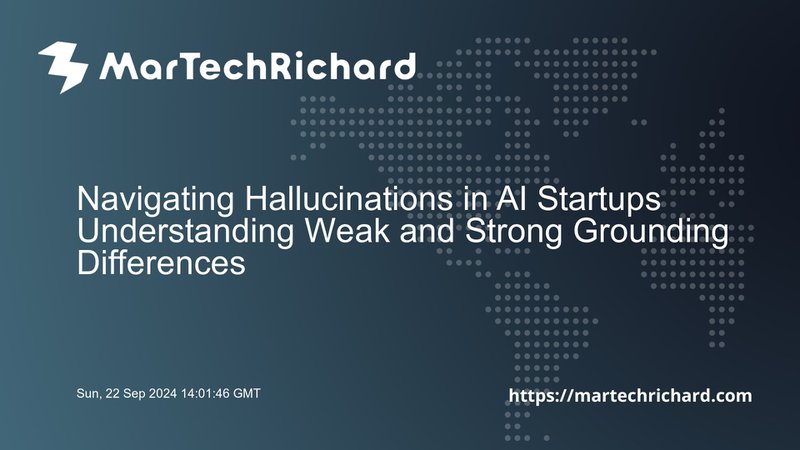
Navigating Hallucinations in AI: Strategies for Robust Document Automation
As the intersection of artificial intelligence and marketing technology continues to evolve, one pressing challenge that emerges is the phenomenon of "hallucinations" in AI systems. This term refers to instances where AI models generate information that is incorrect or entirely fabricated. For professionals in the field of document automation and information extraction, managing these hallucinations is crucial to ensuring accuracy and reliability. In this article, we will explore effective strategies for mitigating hallucinations, drawing insights from industry practices.
Understanding Hallucinations in AI
Hallucinations can lead to significant errors, such as misinterpreting an invoice amount and resulting in severe financial discrepancies. For example, an AI might mistakenly read an invoice total as $100,000 instead of $1,000, leading to a 100-fold overpayment. To prevent such risks, it becomes imperative to implement robust measures that address the potential for hallucinations.
Implementing Human Oversight
One effective approach to managing hallucinations involves incorporating human oversight into AI processes. This can be achieved through various validation methods:
- Human Review: Extracted data is presented to a human reviewer before final submission. For instance, when parsing resumes for an Applicant Tracking System (ATS), a human can confirm the accuracy of the parsed information.
- Automated Flagging: In scenarios where human review is not feasible for every instance, systems can automatically flag data that appears questionable based on predefined validation rules.
Types of Validation Rules
To enhance the reliability of AI outputs, consider implementing these validation strategies:
- Basic Checks: Simple rules ensure that line-item totals match overall invoice totals.
- Cross-Verification: Integrate lookups with existing systems, such as validating payment amounts against purchase orders or historical records.
While these safeguards are essential, it’s important to strike a balance; excessive triggers for manual intervention can undermine the efficiency that AI aims to provide.
Leveraging Small Language Models (SLMs)
Another effective strategy for reducing hallucinations is the use of Small Language Models (SLMs). Unlike their larger counterparts, SLMs are designed for extractive tasks, providing structured outputs by labeling parts of a document rather than generating new content. This approach can yield faster and more accurate results—particularly crucial in time-sensitive applications like resume parsing, where delays can be detrimental.
In practice, a document may be processed using multiple models—only a fraction of which are large language models (LLMs). By carefully selecting which tasks are assigned to LLMs and which are handled by SLMs or other specialized models, organizations can minimize the risk of hallucinations while maintaining high processing speeds.
Distinguishing Between Hallucinations and Mistakes
It’s vital to differentiate between two types of errors in AI outputs:
- Hallucinations: Instances where the model generates completely fabricated information.
- Mistakes: Errors arising from misinterpretation of existing information.
For example, if an AI selects an incorrect dollar amount from a receipt, that’s a mistake; however, if it invents a non-existent amount altogether, that’s a hallucination. Understanding this distinction helps in tailoring mitigation strategies more effectively.
Grounding Techniques for Generative Models
When utilizing generative models, grounding techniques become essential for minimizing hallucinations. Grounding involves requiring the model to justify its outputs based on authoritative sources or context. The level of grounding applied should align with the project's risk tolerance.
Risk Assessment and Grounding Levels
- Strong Grounding: The model must quote verbatim from trusted sources. This approach is preferred when high accuracy is critical.
- Weak Grounding: The model references trusted sources but synthesizes information based on context. This method allows for some flexibility but requires careful monitoring.
For example, in environments with low risk tolerance—such as financial document processing—strong grounding ensures that extracted data matches exactly with source documents.
Addressing Complex Problems with Systematic Approaches
As AI tackles increasingly complex challenges, implementing grounding becomes more complicated. Here are some strategies for navigating these complexities:
- Break Down Tasks: Decompose complex decisions into smaller components that can be addressed individually.
- Utilize Structured Tools: Develop tools that constrain model outputs to specific formats or structures.
- Validation Mechanisms: Establish verification processes to validate final outputs against established criteria or context.
Key Takeaways
In summary, effectively managing hallucinations in AI systems requires a multifaceted approach:
- Prioritize strong grounding techniques to ensure outputs align with original contexts.
- Implement verification steps to catch both mistakes and hallucinations early.
- Assess risks carefully and adjust grounding levels according to project needs.
- Break down complex problems into manageable tasks and identify appropriate models for each component.
By adopting these strategies, professionals in marketing technology can enhance the reliability of their AI-driven solutions and mitigate the risks associated with hallucinations.
For any questions or further clarifications, feel free to reach out at [email protected].
Citations:
[1] https://towardsdatascience.com/how-i-deal-with-hallucinations-at-an-ai-startup-9fc4121295cc
